About this product
Model: askar103_apo_ota
Part Number: ASKAPO103
Optical Bench Test
At FLO, we check all our Askar telescopes on an optical bench before dispatch.
So you can be confident your telescope will have well-figured optics, negligible false colour and spherical aberration, and no astigmatism (the bane of any optical system!). Star shapes will be round, not triangular, oval or egg-shaped!
Askar 103mm APO Refractor.
After a long development period, Askar has introduced its 103mm F6.8 Triplet APO Refractor.
The 103 APO is a highly versatile astrograph and visual telescope with the option of a 1.0x Flattener and both 0.8x and 0.6x Focal Reducer/Flatteners. It is also Binoviewer friendly.
All three accessories have built-in 2" filter threads for direct filter installation. They are also equipped with M54/M48 adapters, and the 0.6x reducer includes an additional M68 adapter ring for convenient connections.
Features
The Askar 103APO features a triplet air-spaced APO lens design, including one piece of ED glass.
An APO (apochromatic) is a telescope that can correct chromatic aberration. Chromatic aberration is a common optical aberration that causes coloured edges or blurring around the edges of objects in an image.
ED glass, also known as low-dispersion glass, is an optical glass specifically designed to reduce chromatic aberration. Chromatic aberration occurs because light of different wavelengths refracts differently when passing through a lens, leading to colour separation and decreased image quality. ED glass has optical properties that minimise chromatic aberration when combined with a high-quality Flint element.
The inner surface of the Askar 103APO's dew shield is covered with a matte felt, and the inner walls of the main tube are coated with matt paint and equipped with internal baffles. This reduces light scattering and reflection inside the OTA, thus enhancing the brightness, contrast, and resolution of the observed targets.
The retractable design of the dew shield and the enlarged locking screws provide convenient usage. The dew shield protects the lens from external light and prevents dew and condensation from forming on the lens surface.
Each Askar 103APO has a unique name ring for identification, making each one exclusive to its owner.
Optional Accessories
The 1x flattener does not change the telescope's focal ratio. After connecting with the Askar 103APO, the telescope focal ratio remains 6.8. The flattener corrects field curvature and coma, resulting in flatter field edges and finer star points.
The 0.8x reducer reduces the Askar 103APO's focal ratio to F5.4. This is a standard reducer with field flattening capabilities as well. A shorter focal ratio allows the OTA to have a wider field of view and faster exposure times, making it suitable for capturing large areas of nebulae, star clusters, and faint, fast-moving celestial objects.
The 0.6x reducer can bring the Askar 103APO's focal ratio down to F4 while providing field flattening. Askar 103APO adopts a detachable tube design, where the rear part of the tube can be removed when using the 0.6x reducer, allowing the telescope to have the necessary length to achieve an F4 focal ratio.
Design
The Askar 103APO works well with a binoviewer, thanks to the detachable lens tube section.
Regarding visual observations, the Askar 103APO can easily achieve focus when connected to a 1.25" or 2" diagonal and most eyepieces.
The Askar 103APO is equipped with a large, rigid 3.3" dual-speed R&P (rack and pinion) focuser, which has 10cm of travel and is compatible with most motorised focusers. There is also a precision scale on the focuser drawtube. The entire focuser barrel is CNC machined and has an anti-reflective internal design and matting paint to reduce internal reflections from stray light.
The rear of the focuser features a 360° rotator with a scale for convenient adjustment and saving of rotation angles. It also has an enlarged rotator locking screw that can quickly secure the focuser, even under high loads.
The telescope interface at the rear includes a 1.25"/2" adapter.
Askar 103 APO Manual pdf
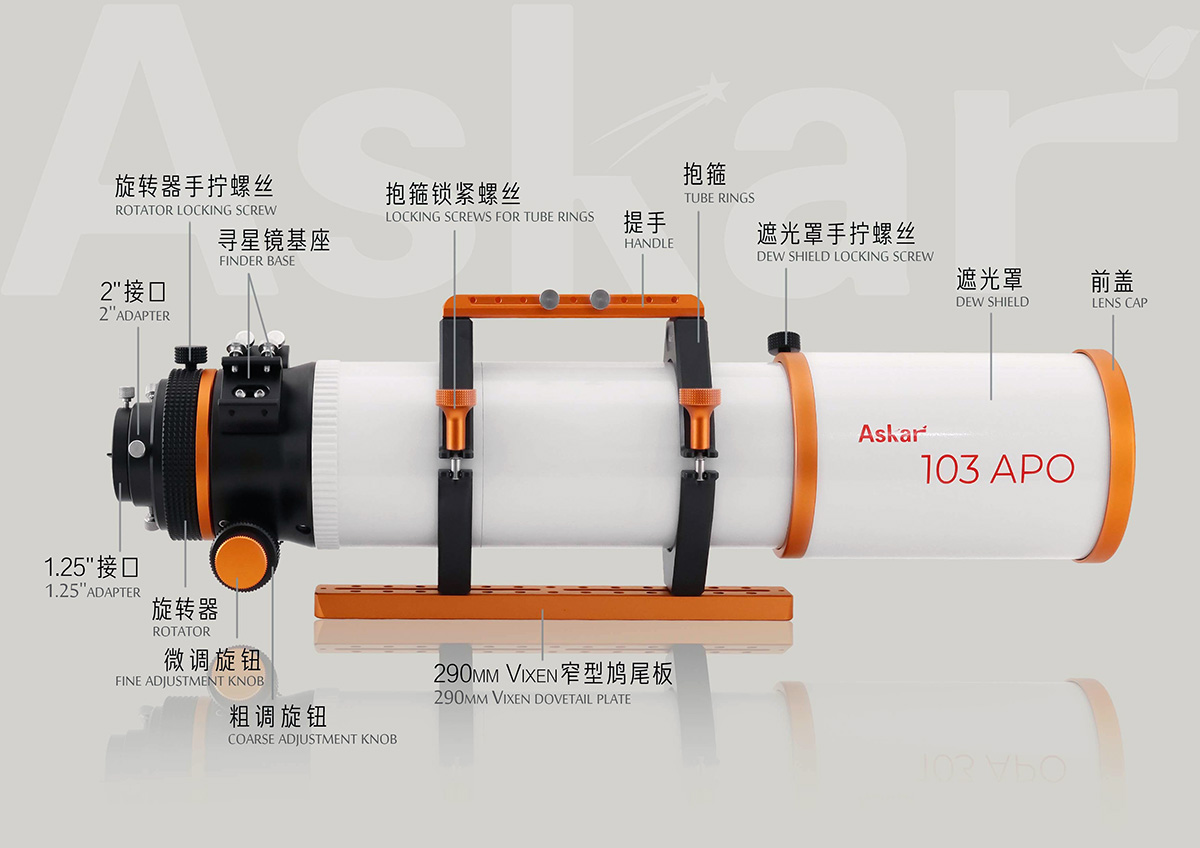
The Askar 103APO tube is crafted using high-quality CNC machining anodising and a surface spray paint treatment. The orange accents add a bright and eye-catching touch, presenting a stylish and elegant overall appearance.
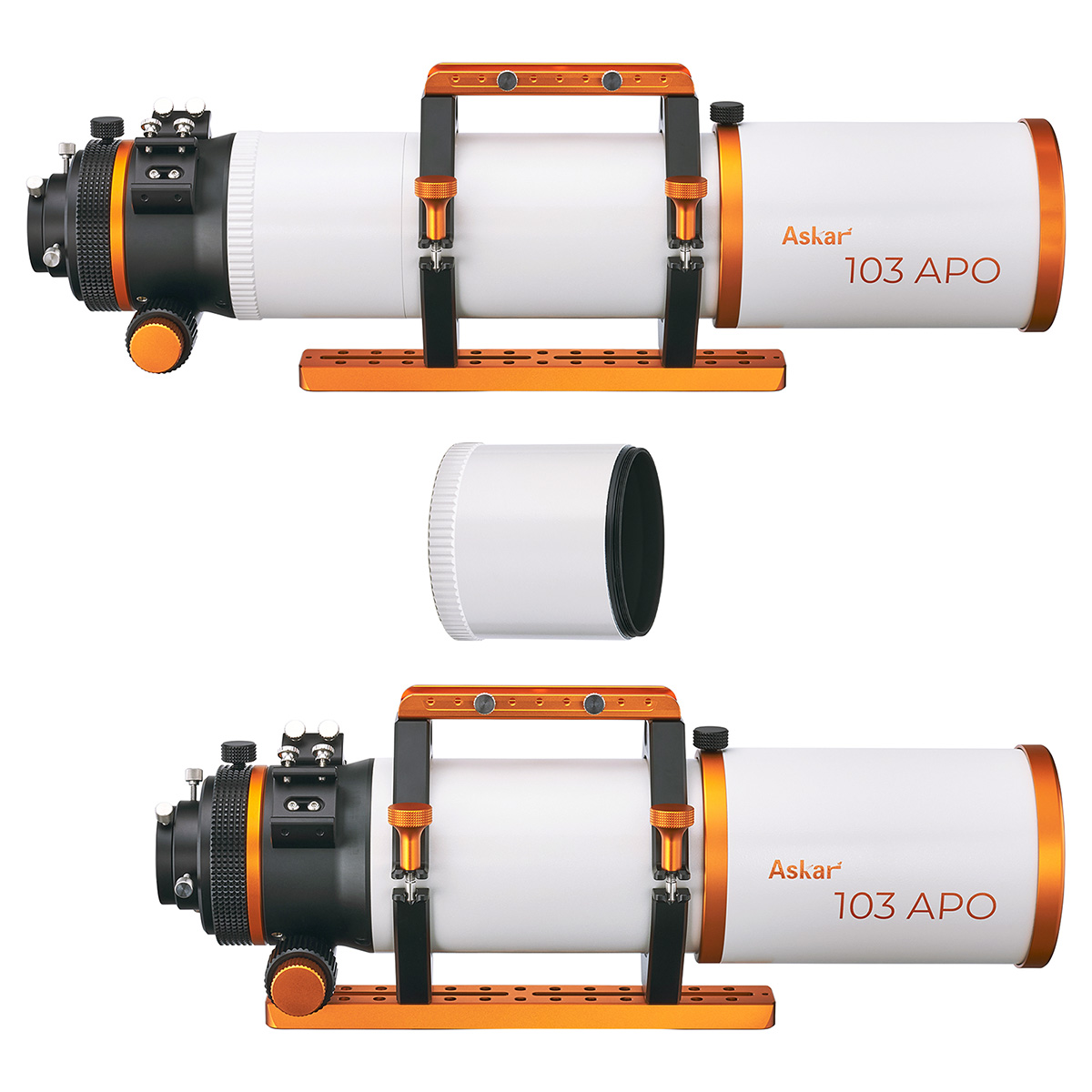
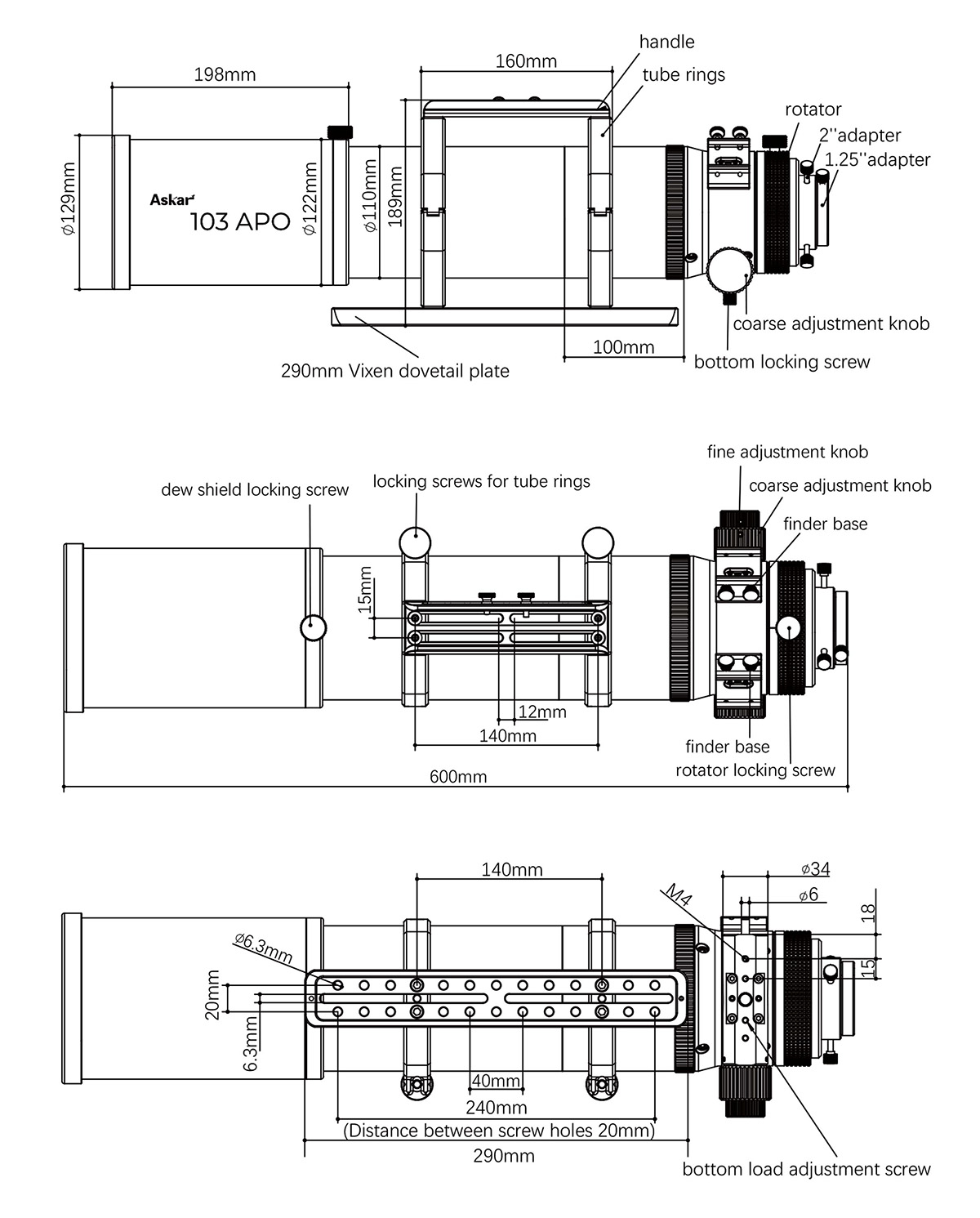
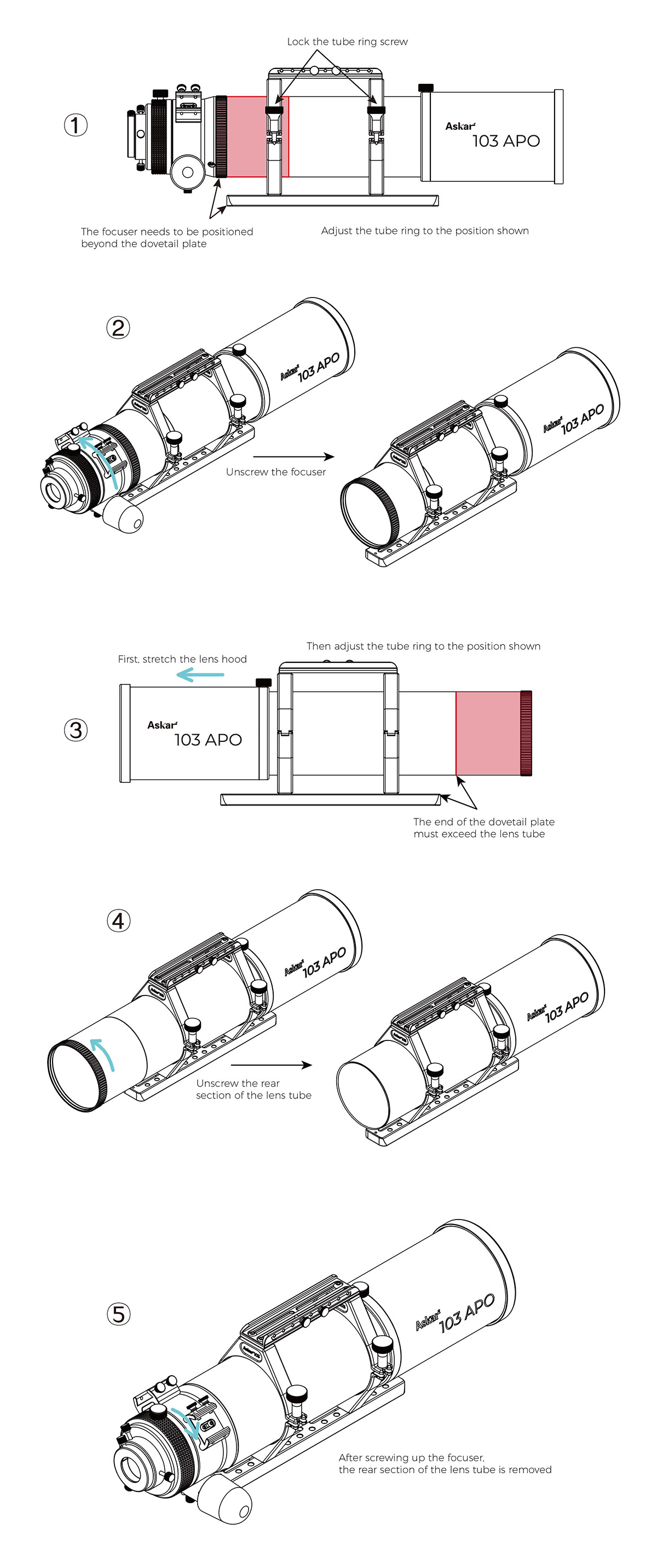
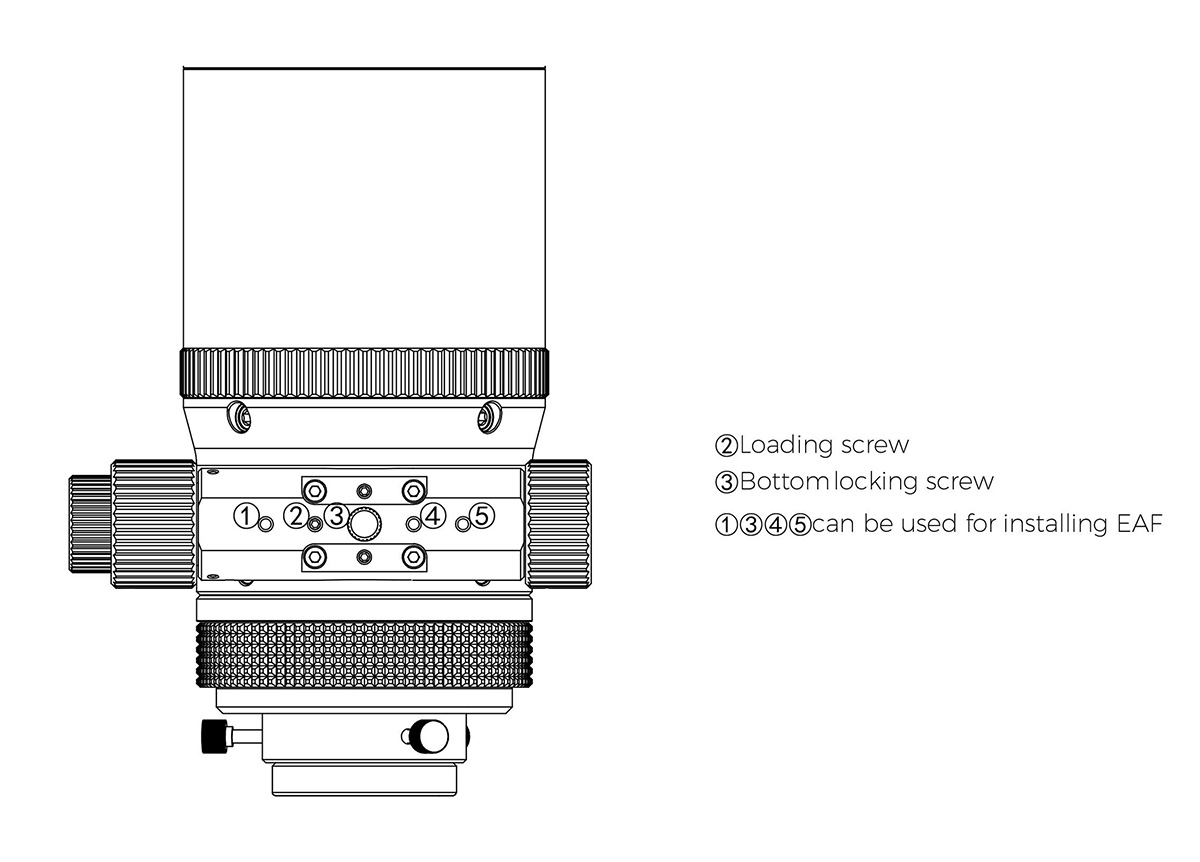
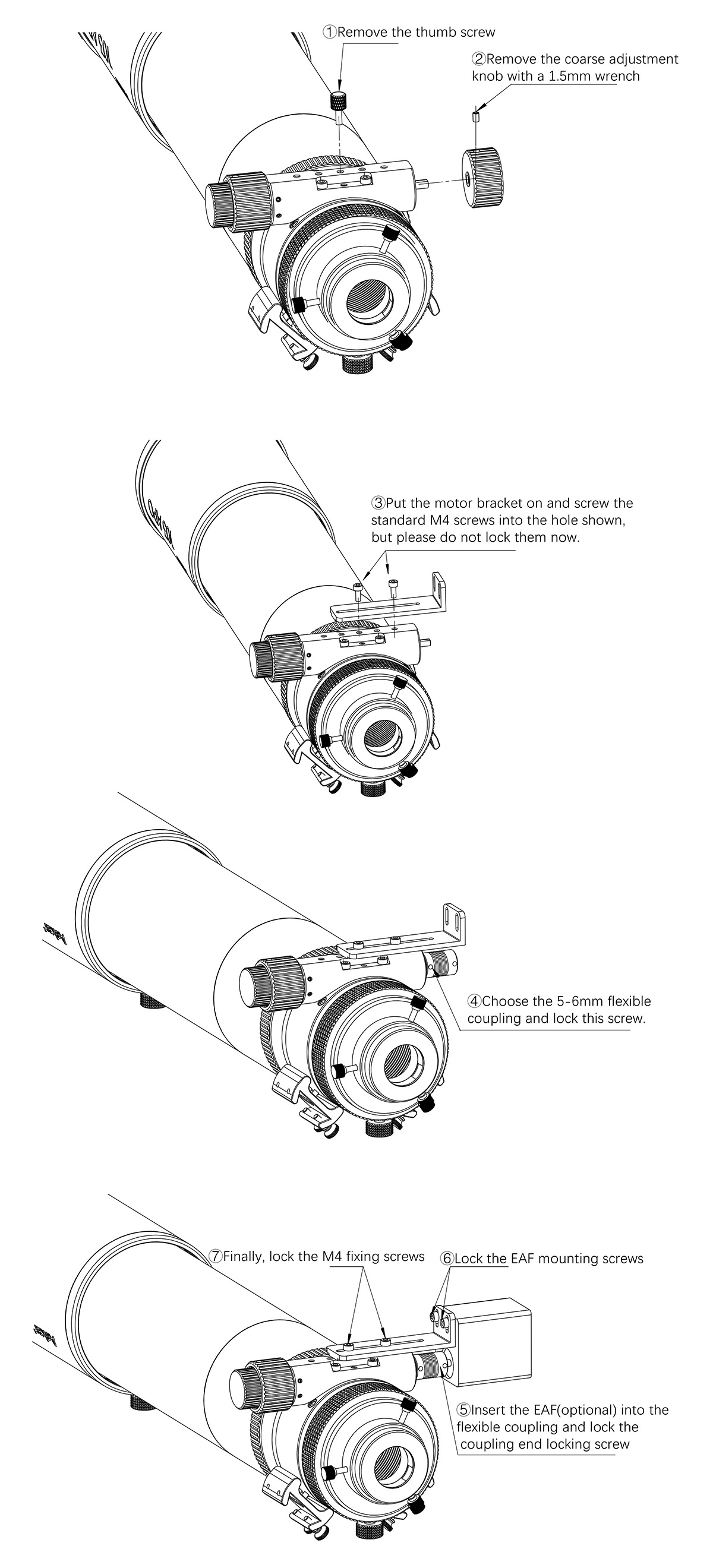
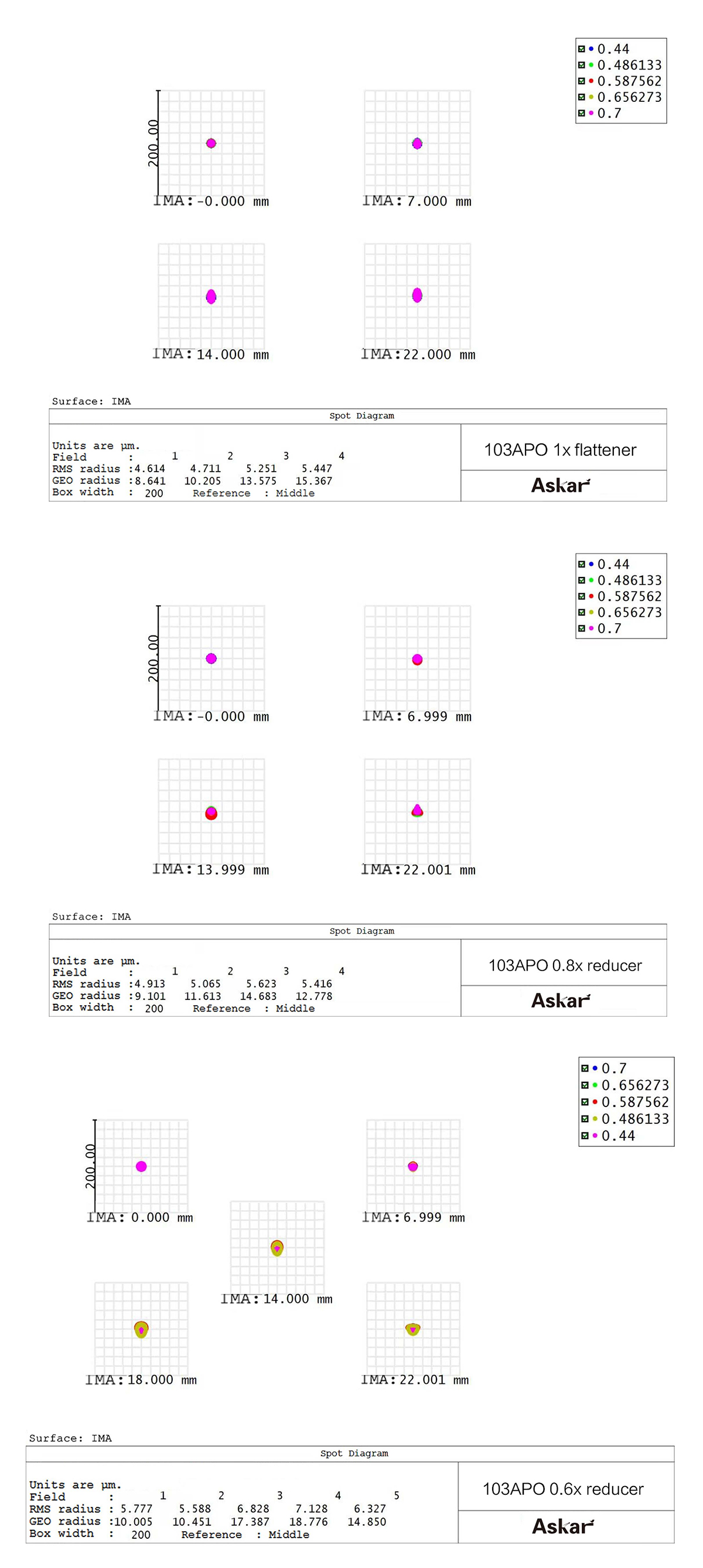
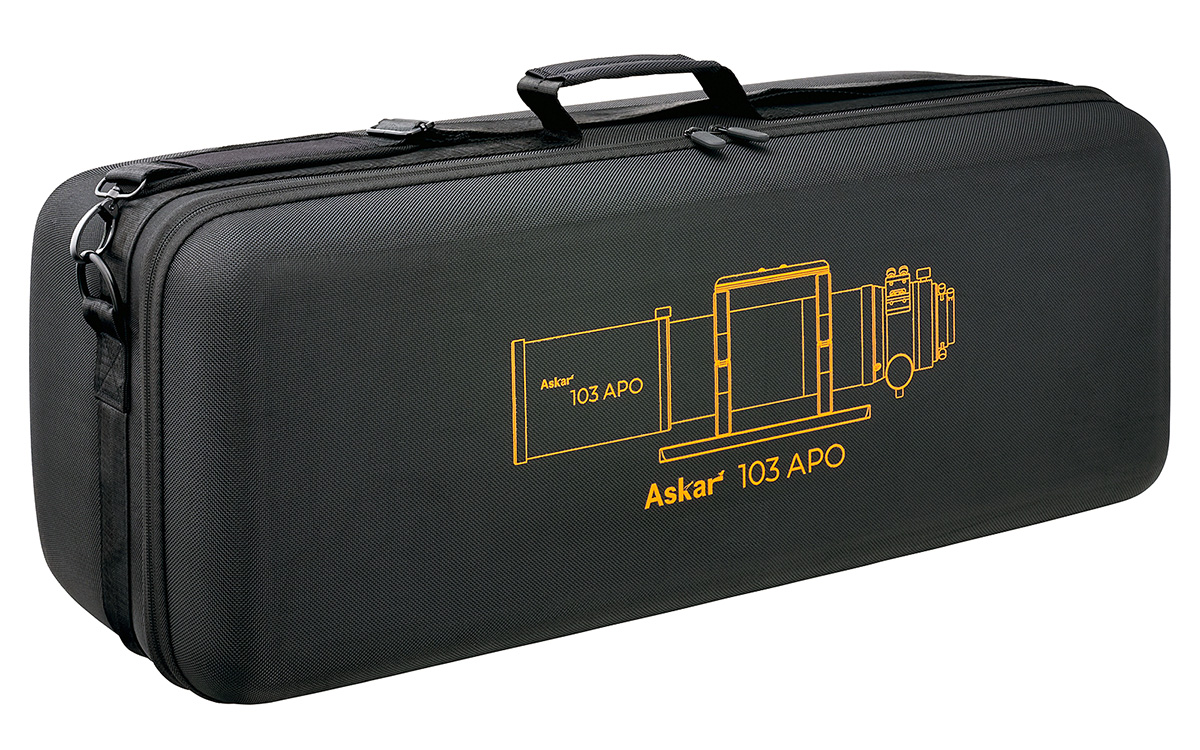
What's in the box
- Askar 103APO
- Tube rings,
- Carry handle
- 290mm Vixen-type dovetail
- Soft carry case
- Manual
Specifications
| Aperture size | 103mm |
| Focal length | 700.4mm |
| Focal ratio | f/6.8 |
| Objective lens | Triplet air-spaced APO (including one ED glass) |
| Total length | 600mm(when the dew shield is contracted)
711mm(when the dew shield is stretched) |
| OTA weight | 4.75kg |
| Gross weight(including tube ring and dovetail plate) | 5.5kg |
| Rear-end thread type | 2"/1.25" visual adapters |
Customer reviews
| Average Rating (3 Reviews): | |
Excellent 4” imaging scope 01 March 2024 | Roger
This is a great scope at a keen price with a triplet objective and a large focuser with built in rotator. Purchased with the matching 0.8X reducer/flattener for a compact and reasonably lightweight rig. The large focuser allows for a fully illuminated circle of 48mm diameter, enough to cover a full-frame sensor. The fit and finish is very good and the orange accent colour makes it look attractive. An artificial star test reveals an airy disk and single diffraction ring at focus with no false colour, although the rings are not identical either side of focus. The included handle doubles up as a guidescope ramp which assists with balancing and makes for a neat set-up with minimal flexure. Anyone in the market for such a scope would do well to consider the Askar on their shortlist.
29 February 2024 | Paul
I have had my Askar 103mm with the 0.8 reducer for just over a month now. Because of persistently wet weather, have only had 4-5 opportunities to use it, but I'm very happy with the results. Visually, I have used it at the full 700mm FL with two BST Starguider eyepieces and a Televue 2.5x powermate. I have been observing the moon with smaller refractors, a 6" Newtonian and my C8 (8" SCT) on and off for about 58 years, and I have never had such impressively sharp views and so much detail and contrast with any scope before. At First Quarter, the views into terminator craters, with mountain and crater floor detail, and the close-up view of the Hyginus rille (cleft) were jaw-droppingly good. On the same evening, I did a tour of the sky using the go-to function on my HEQ5 mount, and it was interesting to see some of the objects visually that I have been photographing over the past couple of years. Messier 101, 63, 51, and the Leo Triplet were all picked out with no trouble at all, in spite of fairly intrusive moonlight. Even the Owl Nebula was glimpsed. Views of open clusters M44, M67, M35 and the Double Cluster were really spectacular, with a profusion of stars on a nice, flat field against a velvety background.
Imaging so far has been using the 0.8 reducer, and my cooled ASI533MC camera. Star colour is very well rendered with no false colour intruding. Star shapes are good right across the field. The rack and pinion focuser needed tensioning up a little, as the weight of the camera caused the focuser to rack out if the scope was pointing above about 30 degrees. This was achieved in less than a minute by tightening a small hex bolt under the focuser. There is of course a separate locking screw as well. Focuser travel is very smooth in both coarse and fine modes, but I was surprised that even with the generous amount of travel available, I still needed an extender to find focus visually without the reducer. The scope balances nicely on the HEQ5 mount and achieiving sub 1.0" error is not a problem. (non belt-modded mount)
I am very satisfied with the results so far on deep sky objects, and the FOV with the 533 and the 0.8 reducer is ideal for medium-sized DSOs such as M78 (Orion), and eg. the Tadpoles or the Fish Head nebulae. Larger galaxies like M101 and M81 show plenty of detail, although obviously 700mm doesn't give quite the reach needed for smaller objects. Moderately widefield views of galaxy groups should be stunning. This week I have captured Comet Pons-Brooks at 560mm, with tail detail right to the edge of the picture.
In summary, to date I am very happy indeed with the scope, and looking forward to exploring its capabilities further. As always, the service from FLO was impeccable, with the instrument arriving ahead of the estimated delivery time. I just wish they'd stop putting clouds in the box!
ASKAR 103 TRIPLET - GREAT BUILD QUALITY, GREAT OPTICS, VERY VERSATILE AND AMAZING VALUE. 14 November 2023 | Paul
I was looking for a four inch apo for visual use to compliment my 10inch Starsense Explorer Dob, and 80mm ED doublet ((Altair 80 ED-R). I had owned a 102 Tecnosky F7 previously - FPL53 and Lanthanum doublet - which came from the same stable as the Starfield and several others. I was very pleased with the Tecnosky, very sharp images, good contrast and virtually no CA to note.. So, the natural thing to do was buy the well respected⁷ Starfield version with the same optics of the Tecnosky.
I though I'd check out the current crop of 102 apos anyway, I couldn't see anything that looked better than the Starfield - and then I happened to come across an ad for the new Askar 103 triplet. Here was a triplet with all the extra features (including two finder feet fitted, a handle with the capacity to add more finders/accessories if necessary, binoviewer friendly, graduated field rotator, 3.5 inch R&P focuser, a case etc). All this for a triplet only about £100 more than the Starfield. I had set my heart on a four inch that would be at least on a par with the Starfield, Tecnosky etc range of doublets in terms of optical quality.
There is little on line about this scope yet as a visual instrument, but there are a few good reviews on imaging with it on u-tube and other places. They all seemed fairly positive to me, and Askar has a good, if young, pedigree, so I took the plunge and placed my order.
I've had the scope since Nov 1st and have had about nine hours with it under the stars. So how is it doing?
The fit and finish of the scope is excellent and is of a high standard. The sliding dew shield, focuser and image rotator work very well. Attention to detail is very good, it even comes with two finder screws on the handle which fit into two holes at the ends of the dovetail to stop it slipping through an untightened clamp. The handle is very sturdy and has numerous holes to fit accessories to it, and along with the two finder feet (and two multiple finder adapters I already have) makes it possible to attach accessories in at least nine positions.
This is particularly helpful for me as it makes it very easy to adapt to use the excellent Starsense Explorer push to location system which I have already used with it.
Now the important bit - the optics. I need not have worried, the views I have had indicate they are of a high quality, and certainly are worthy of a very good triplet - if used visually or for imaging. The sharpness, and contrast on Jupiter and the Moon have been very good indeed, despite less than ideal conditions. One morning when the GRS was in view and also Ganymede and its shadow was particularly memorable. Star images are really tight, and I was surprised with the number of faint background stars visible when looking at some deep sky objects. The Orion nebula showed greatly detail in swathes of swirling nebulosity with the background a lovely inky blackness. The colour of stars were also very evident for a four inch scope. The most surprising thing to me was when I observed Vega one night. Admittedly it was at a high altitude - though the seeing was not great. When I focused in on it with my 12.5 Morpheus it was reduced to a beautifully small and pure white airy disk. I watched it for several minutes, and it did not vary in appearance, I knew then I had made a good choice.
One thing, it is a fairly hefty scope compared with a doublet, coming in at 6K / 13.5 lbs with rings, dovetail, handle and a 1 25 inch prism - no finder. I was using it on an AZ5, fine up to about x100 but difficult as you increase the mag. past this. It deserves more stability if you intend to use it to its full capacity. To this end I have just bought a used Vixen GP which is on the way!
In use, straight out the house, I had no problems with it taking a long time to cool down. If you do have any problems - it's worth the wait!
Finally, when I tried to remove the section of tube off to put it in bino or reducer-mode, I couldn't grip the tube hard enough to undo it. I now own a strip wrench which did the trick!
FAQ
Please fill in the form below to ask a question.